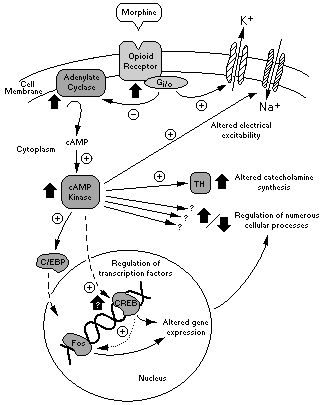
Scheme illustrating opiate actions in the LC. Opiates acutely inhibit LC neurons by increasing
the conductance of a K+
channel (light cross-hatch) via coupling with subtypes of Gi and/or Go,
and by decreasing a Na+-dependent
inward current (dark cross-hatch) via coupling with Gi/o and the consequent
inhibition of adenylyl cyclase. Reduced
levels of cAMP decrease cAMP-dependent protein kinase activity and the
phosphorylation of the responsible channel or pump (or closely-associated
protein). Inhibition of the cAMP pathway also decreases
phosphorylation of numerous other proteins and thereby affects many additional
processes in the neuron. In addition
to reducing firing rates, for example, inhibition of the cAMP pathway
decreases catecholamine synthesis via reduced phosphorylation of TH, as
well as initiates alterations in gene expression via regulation of transcription
factors [e.g., reduced phosphorylation of CREB (associated with reduced
nuclear translocation of the protein kinase catalytic subunit); reduced
expression of c-fos and other IEGs (possibly mediated via CREB--dotted
line); and reduced activation and nuclear translocation of C/EBP, CCAAT-enhancer
binding protein(s)]. Dashed lines
indicate nuclear translocation of a protein.
Upward bold arrows summarize effects of chronic morphine in the LC.
Chronic morphine increases levels of Gia
and Goa, adenylyl cyclase, cAMP-dependent protein
kinase, and several phosphoproteins including TH. These changes contribute to the altered phenotype of the drug-addicted
state. For example, the intrinsic
excitability of LC neurons is increased via enhanced activity of the cAMP
pathway and Na+-dependent
inward current, which contributes to the tolerance, dependence, and withdrawal
exhibited by these neurons. As
another example, the capacity of the neurons to synthesize catecholamines
is increased via induction of TH. This
altered phenotypic state may be maintained in part by persisting changes
in transcription factors (e.g., CREB, c-Fos, C/EBP). From 40.